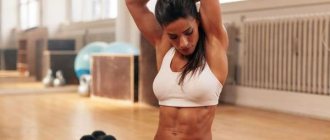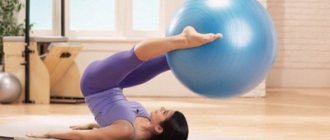Author: Timko Ilya - the ruler of the entire site and fitness trainer | more details >> Rod. 1984 Trained since 1999 Trained since 2007. Author and creator of the site tvoytrener.com. CCM in powerlifting. Champion of Russia and South Russia according to AWPC. Champion of the Krasnodar region according to IPF. 1st category in weightlifting. 2-time winner of the Krasnodar Territory championship in t/a. Author of more than 700 articles on fitness and amateur athletics. Author and co-author of 5 books.
Place in the author rating:
out of competition
(become an author) Date: 2016-12-22 Views: 138,616 Rating: 4.9
| All articles by the author >> | Medals articles >> |
Articles are loading...
| Article medals: | more than 100 thousand views |
Why medals are given to articles:
| Bronze medal: | |
| 1. The article is in the TOP 100 2. The article has more than 3. The article has more than 100 | |
| Silver medal: | |
| 1. The article is in the TOP 50 2. The article has more than 3. The article has more than 500 | |
| Gold medal: | |
| 1. The article is in the TOP 10 2. The article has more than 1 3. The article has more than 1,000 | |
This is a video article. The entire article is presented in this video. Below is just a text transcript of the video. Enjoy watching!))
How to warm up before a workout
Girls, who among us hasn’t started studying at home at least once in our lives?
Who doesn’t want a slim, toned body without spending a lot of time and, most importantly, money? After all, gyms or fitness centers are not the cheapest pleasure. Did everyone get results? No, of course, many despaired and, without noticing the effect, abandoned training. But the problem most often is that we do it incorrectly, did you start doing the exercises unstructured, and without any basic training plan? Most often this happens when we suddenly decide to take care of our body this very minute and begin to jump vigorously, then do push-ups and then turn our heads. In general, the result is not a workout, but a hodgepodge of those exercises that you remembered from distant school physical education lessons.
Photo from r-art.org
How to create a lesson plan so that the result still comes? In this article we will talk about what you need to do first - how you need to prepare for training, what exercises will warm up the body so that the training itself gives the maximum effect, and how exactly they need to be performed technically.
Important
In order to achieve noticeable results, you need to follow a system of exercises and perform them technically.
Finishing the workout - cardio
The last and final stage of the workout will be slightly different from the previous ones. All the previous exercises were designed to warm up your muscles, stretch them properly, after which you can strain them without the threat of damage, stretching or tearing. But that's not all the warm-up is for. As mentioned earlier, during heavy exercise, not only your muscles are subjected to serious stress, but also your heart (which is also a muscle). But you won’t be able to stretch it using standard methods, so you will have to resort to a special workout, preceded by a cardio prefix. The idea is to increase the workload on your heart a little so that it is ready for the strenuous exercise you are about to do. Cardio warm-up is quite simple: you need to alternate between jumping and jumping for about three minutes. This combination will give you the desired result, and during training you will no longer experience heart problems, shortness of breath, pain in the chest, side, and so on.
To reduce the risk of sports-related injuries, there are a few important things to know. One of them is the need for careful preparation for physical activity. It is enough to properly warm up the leg muscles so that subsequent training exercises and tasks do not seem so difficult and insurmountable.
All the benefits of exercises for warming up muscles are difficult to overestimate. A properly done warm-up helps improve blood flow to the working muscles of the legs, which helps reduce their stiffness and excessive tension. Additional benefits include the athlete’s positive psychological mood, which certainly appears after the release of hormones responsible for the production of the body’s necessary energy.
But there is no need to confuse warm-up and stretching exercises; they have different functions for the muscles and must be performed in the correct sequence. How to warm up the leg muscles correctly and relatively quickly in order to increase the effectiveness of the exercise and reduce the risk of injury. Universal exercises that should be performed without fail before each workout or muscle stretching will help with this.
The fundamental thing is jogging, which begins with a normal step, gradually developing into an intense run. This exercise can be done both on a machine that simulates a treadmill, and in the fresh air, which is the most useful.
After this, it’s worth starting lunges, this is when one leg is fixed in place, and the second is thrown forward with a sharp movement, bending at the knee, the body weight transfers to it, and back. This is repeated from the other leg, and so on 10-15 times for both limbs. Now you can start running again, just not for as long and in place. After each exercise, be sure to shake off your legs, alternately relaxing one or the other in a free position.
Some movements come naturally during warm-up; your body begins to feel how to warm up the muscles of one or another department. It is good to make swinging movements with your legs, first with your leg bent at the knee, then in a straight position. Alternate swings forward and backward and to the sides. Also stick to the number of exercises done, 10-15 times on each leg and in each direction.
After completing the exercises, you can warm up by playing ball or jumping rope. When your body is ready for a full workout, you will feel it immediately. At the end of the first and second stages, the final action will be exercises aimed at stretching warmed and trained muscles. Now we can say with confidence that everything was done correctly and with maximum benefit.
Warm-up before training at home for girls
If you vigorously warm up your body and all your muscles, you will fully prepare yourself for the subsequent load. As you can guess, you will be less tired and, accordingly, you will be able to do more approaches and a longer workout, which will ultimately lead you to getting results. How does this warm-up exercise work?
Photo from the site sunny7.ua
All these exercises should increase your heart rate, increase blood flow through muscle tissue and, very importantly, in order for your joints to withstand the load without problems, joint lubrication must be released, which will not allow them to overstrain. All this together will help you protect your body from unexpected injuries.
Well, now let's talk more specifically.
Exercise program
Let's look at a set of exercises that anyone can include in their warm-up and training program. Combined warm-up (total duration 10-15 minutes), consisting of a series of aerobic and stretching exercises.
Note : It is unnecessary to give a technique for performing the warm-up complex, because all the exercises are extremely simple, so we will limit ourselves to only the visual picture series.
Exercise No. 1. Walking in place (3-4 minutes).
Exercise No. 2. Knee raises (30 times in 30 seconds).
Exercise No. 3. Squats (15 reps).
Exercise No. 4. Triceps stretch (4-5 reps per arm).
Exercise No. 5. Shoulder rotation (2 sets of 12 reps).
Exercise No. 6. Stretching the pectoral muscles (8-10 repetitions).
Exercise No. 7. Back stretch (6-8 reps).
Exercise No. 8. Hip stretch (5 sets of 5 seconds on each leg).
Here is a set of 8 general exercises that you can use to prepare for training.
It is quite universal and applicable to both men and women.
Dynamic and static warm-ups: pros and cons of each
Everyone is accustomed to warming up like in old Soviet films - these are “stretches”, in other words, this is stretching. But the question arises: how similar are stretching and warming up? Are they the same thing, or is there a difference in the understanding of these words? Recently, professional trainers have argued that these two concepts are not similar to each other. Let's figure out why. This conversation directly relates to what kind of workout you plan after you warm up. Cardio warm-up before training video:
If you are expecting a strength load and want to increase your strength levels, you will need a dynamic warm-up. What it is? We are all familiar with the word dynamics, and it is obvious that this warm-up does not imply smooth and measured body movements, as well as not static positions. To prepare your body for strength training, you need fairly vigorous exercises; they will maximally help prepare the body for the subsequent load on the muscles.
Photo from turnichok.ru
You will be interested to know that studies have been conducted on army personnel, and after such an exercise, the heart rate increases, the body temperature rises, the muscles become elastic, and the joints begin to move much better. In addition, nerve conduction increases and muscles become more responsive to stress. What conclusion can we draw from this study? The body perceives the training better and the result for which you are trying so hard will be more noticeable. Warm-up before training at home video:
If you do stretching, yoga or any other exercises that do not require large strength investments, of course it will be better for you to use the old method - warm up your muscles, do some stretching, and then proceed to the main block of the lesson.
Important
The warm-up should correspond to the chosen direction of home training.
Below we will answer the question of how to warm up before training if you are seriously planning to “lift” a barbell or pick up your home dumbbells.
Body lifts
Warming up before training at home for beginners should definitely include an exercise that will warm up the abdominal muscles, since this is a very important muscle group. They are involved in almost all the exercises of the workout itself, so the abs need to be strengthened first. This exercise should be performed for a longer period of time - about two minutes. You need to lie on the floor, stretch your legs, then lift your body and look at the toes of your feet. This will have a slight impact on the abdominal muscles. If you do not feel any effect on your abdominal muscles, you can gradually increase the angle of the body. It all depends on your individual characteristics. You can even raise your body to a ninety-degree angle, and then reach your toes with your fingers if you feel that you are capable of this.
Warm-up exercises before training
First, we must warn you about exactly how your warm-up should proceed, this is important, pay attention. At the beginning, the pace should be as slow as possible, remember that the body cannot warm up quickly. The range of your movements should also not be very wide.
Photo from the website www.ufest.in.ua
Over time, increase the tempo and amplitude, but gradually, without sudden jerks. These are actually important rules, which are explained by the fact that the warm-up should prevent rapid fatigue in the muscles and in no case should it be too heavy so that the entire training complex does not end at the very beginning. Well, let's get started!
First exercise
First we will warm up the back, shoulders and hips from behind. We stand straight, place our feet shoulder-width apart, and stretch our arms up. Relax your neck, while keeping your head straight. From this static starting position, we bend down, lower our arms along with the body, directing the body in an arc. Try to extend your arms between your legs as far as you can without lifting your heels off the floor. Let's go back to the source. Remember the pace - perform this exercise slowly.
Photo from ekrasota.com
Second exercise
The next exercise will involve the shoulder area, gluteal muscles, quadriceps, and also remains a load on the back of the thighs. In the starting position, the pose should be like this: stand straight, fully straighten your back and relax your muscles, put your hands on your hips, and put your legs together.
From this body position, we take a wide step back with our right foot and rest our toes on the floor. Now lower yourself, that is, you need to sit down on both legs and raise your arms up, stretch as if you want to reach the ceiling with your fingers. It is important that at the moment when you sit down, your knees should bend at an angle of ninety degrees if you are a beginner and have just started doing physical exercises. exercises, and you can’t squat so deeply, just try to increase the angle at least a little each time.
Photo from the site beauty-proceduri.ru
So, your back knee shouldn't touch the ground, but again, this is ideal, and if you do hit the ground, try to keep the impact gentle - don't plop down on your knee. The body weight in this exercise must be distributed correctly, that is, you should mostly focus on the front leg. From this position, return to the starting position and repeat the same thing, only now starting on your left foot. Still remember to keep the tempo low for the second exercise in the warm-up.
Third exercise
The next stage for warming up the body will be the impact on the stomach, we will warm up the abdominal muscles - obliques and straight ones with one exercise at the same time and we will use the spinal muscles. As usual, we get up to the starting position - we straighten up, while we place our legs shoulder-width apart and spread our arms to the sides, hold them in weight, try to make sure that the arms form a single line with the line of the shoulders. We turn our palms towards the ceiling. We look straight ahead and tense the muscles on our stomach – the abs.
Photo from tennis74.ru
From this body position we will make turns. How to do this technically and correctly? We fix the head and do not turn the neck during execution; the legs and hips will also not move on their own. But the shoulders turn to the side so that one arm is behind your body, and the other in front. Since we are still not increasing the pace, we need to pause in the middle, sort of “hang” in the position and then repeat, only now in the other direction.
Fourth exercise
Next we will focus on warming up the abdominal muscles. Now our initial body position will be radically different: you should lie on the floor on your back, stretch your arms above your head, bring your legs together and try to straighten them completely. Now slightly raise your head from the surface a couple of centimeters.
Photo from the site xn--80aaaa0cbbw3c8b3c.xn--p1ai
From this position you need to lift yourself to a sitting position, but the trick is that you can’t use your arms or legs for this, your abs will help you. You bend your legs and place both feet on the mat while contracting your abs. In the intermediate position, your arms should be pointing in front of you. Now unbend and slowly, smoothly and softly lie down on the floor, so that your head falls down gently. While performing this exercise, the pace can be increased to medium.
Fifth exercise
Next, let's work on the shoulders and back. We lie down on the floor, only now we lie on our stomachs, our head and arms should be raised from the training mat a couple of centimeters, while we hold ourselves straight and look down, as if underneath ourselves. The muscles in your stomach automatically tense.
Photo from fitnessplus.ru
We will raise our chest as high as possible, simultaneously spreading our arms to the sides. Don’t let beginner athletes be scared; at first this exercise is a little difficult, but over time you will be able to bend more and more. Now we return to the starting position, rest for a few seconds and repeat this exercise. The pace will depend entirely on your preparedness, advanced athletes can perform bending exercises at an average pace, those who are just starting to exercise will do it more slowly.
Sixth exercise
We move on to warming up for the legs, shoulders and buttocks. in the starting position, the body will look like this: your legs should be shoulder-width apart, even a little wider, your arms should be lowered down, your body straight.
Photo from just-fit.ru
Squat down, bending your knees at right angles so that your thighs are parallel to the floor. Having lowered our arms, bend them at the elbow joints and raise them forward. Now jump up from this position and try to touch the ceiling with your hands. We land from the jump softly and immediately on half-bent legs, then go back into a squat, and so repeat the exercise, performing the set. Here the pace rises to moderate even for beginners.
Seventh exercise
Moving on to more complex loads, do you notice how not only the pace changes, but also the force with which this or that action is performed? Now we will work on the arms and pectoral muscles. Everyone has done push-ups at least once in their life, right? Does everyone remember how to do this school exercise correctly?
In the starting position, you should take an emphasis in a lying position, with your arms spread far apart, your elbows turned to the sides, and your feet together. Your head should be in one continuous line with your spine, and your face should be facing down.
Photo from sportrt.ru
From this position we will perform push-ups. We bend the elbows to form a right angle at the joint, make sure the back is straight, the lower back should not sag, because this will lead to improper distribution of the load. Now we straighten our arms, returning to the starting position. The pace can vary from medium to faster.
Eighth exercise
We will again warm up the abs, oblique muscles on the abdomen and back. Everyone also tried this exercise at least once in their life, in the same school lesson, everyone remembers how they twirled their hands in a “windmill”? Spread your legs wider than in all previous exercises, and spread your arms to the sides so that they are parallel to the floor, strain your abs, and keep your head straight.
Photo from the site zolotaya-info.ru
Now lean forward with your whole body, without hunching your back. With your right hand you need to reach your left leg and return to the starting position, then repeat the movement, only now with your left hand to your right leg. This block of warm-up is quick.
Ninth exercise
So, we have warmed up almost all the muscles and now we will warm up the whole body at the same time. Stand up straight and bend your arms at the elbow joints.
Photo from the site strong-life.ru
We run in place, but not just like that, but throwing your knees high, take ten such high running steps and rest for a few seconds. Don’t forget that this exercise is aimed at warming up all the muscles, so your arms should also be tense and move along with your whole body, and be sure to tense your abs. This exercise should be performed at the fastest pace you are capable of.
Well, that's all, these exercises make up an excellent set for warming up before training at home.
Types of warm-ups
The main thing you need to understand is that there is no exact warm-up complex. In each individual case, the program can be selected separately. For example, before running, an incline is done to warm up the legs, while when working with a barbell, the whole body should be prepared.
Warm-up can be of several types:
- General . This category of exercises is designed for functional training of the whole body. Due to this complex, there is a gradual increase in temperature, metabolism is activated, due to which more oxygen enters the muscles. The general warm-up includes a complex for the upper and lower extremities, light running in place, jumping and rotational exercises to develop joints. Time: 10-15 minutes.
- Special . Here, muscle warming is aimed at 10-20% load on the body specifically for a specific type of training. For example, if this is an exercise with dumbbells, then do 10-12 repetitions on your hands. Its main goal is to “remember” the body how to perform the exercises correctly.
- Cool down . At this stage, the main task is to help the muscles relax so that they move away from the excited state. Typically, a cool-down includes slow running, with a gradual transition to walking, and smooth stretching of the body in different directions. Such exercises allow you to remove lactic acid, reduce your pulse and temperature, which normalizes blood flow in the body. Time: 5-10 minutes.
- Stretching. There are 3 types of it:
- statistical – exercises are designed to fix the limbs in a certain position;
- dynamic – exercises allow you to control the course of muscle action;
- ballistic – movements are fast, motor, chaotic.
Dynamic stretching gives the most maximum effect, as it gradually warms up the muscles, which means the risk of injury to the fibers is minimal.
All four stages of stretching should be performed sequentially, without skipping any. The fact is that at each stage the muscles are not just prepared - they are first warmed up (in the literal sense of the word), and then gradually stretched and brought into a “working” state. A “cold” body is easy to injure.











